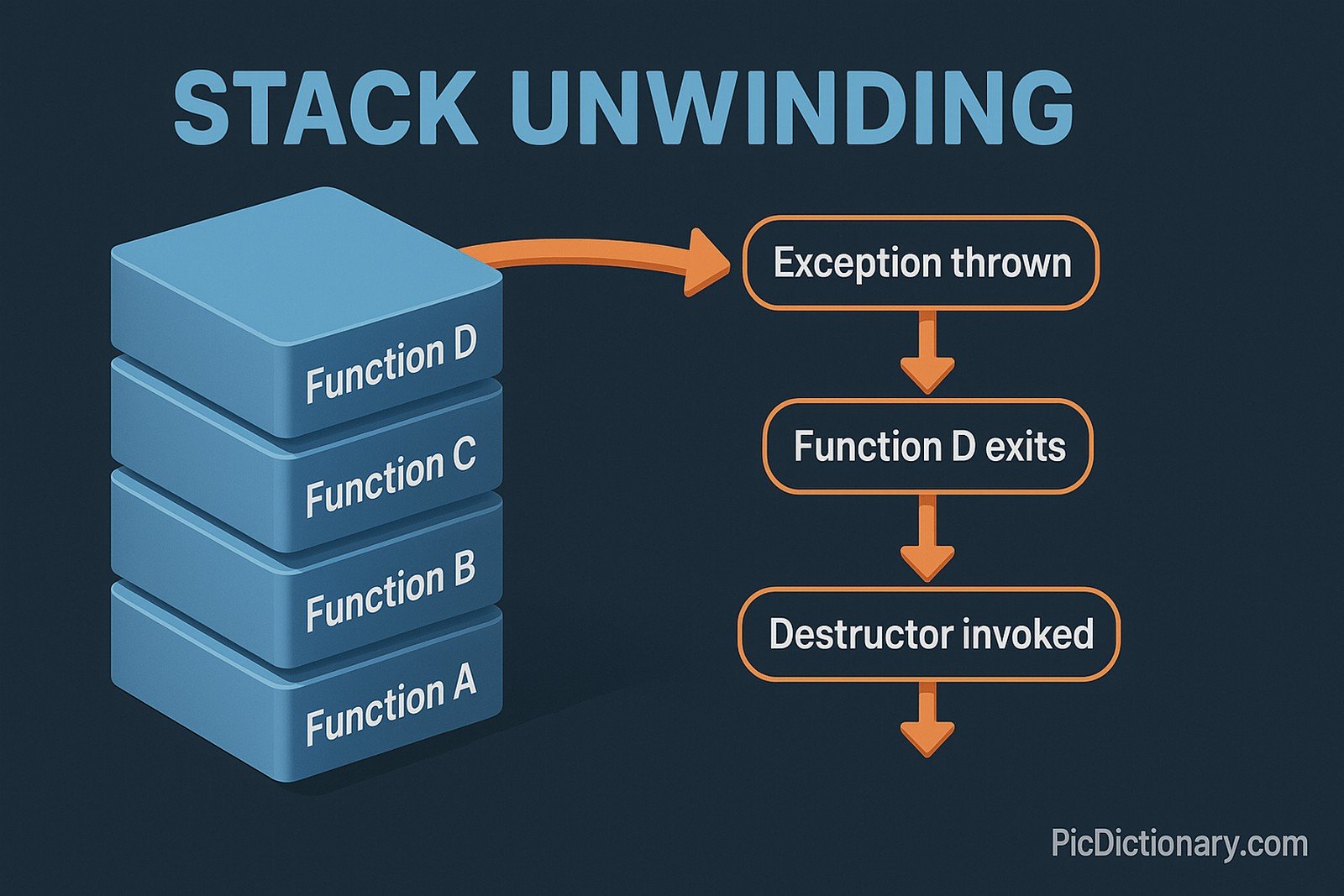Stack Unwinding

Quick Navigation:
- Stack Unwinding Definition
- Stack Unwinding Explained Easy
- Stack Unwinding Origin
- Stack Unwinding Etymology
- Stack Unwinding Usage Trends
- Stack Unwinding Usage
- Stack Unwinding Examples in Context
- Stack Unwinding FAQ
- Stack Unwinding Related Words
Stack Unwinding Definition
Stack unwinding is the process in programming where function calls are removed from the call stack in reverse order when an exception is thrown or a function exits. During this process, destructors of local objects are invoked, ensuring that resources are released properly. Stack unwinding is a critical part of exception handling in programming languages like C++ and Java, ensuring memory cleanup and preventing resource leaks.
Stack Unwinding Explained Easy
Imagine you have a stack of books, and you carefully place one book on top of another. When it's time to remove them, you start from the top and remove them one by one. Stack unwinding is like that—when a function is done or an error occurs, it removes function calls from the stack one by one, cleaning up as it goes.
Stack Unwinding Origin
Stack unwinding as a concept emerged with structured programming and exception handling mechanisms. As programming languages evolved, stack unwinding became an essential feature to ensure proper resource management and control flow, especially in languages that support exception handling like C++ and Java.
Stack Unwinding Etymology
The term “stack unwinding” comes from the idea of “unwinding” a sequence of operations in a stack, meaning to reverse the stacking process, ensuring each function properly exits before returning control to the caller.
Stack Unwinding Usage Trends
With the rise of modern programming languages emphasizing robustness, stack unwinding has become crucial in software development. It is widely used in operating systems, game engines, and enterprise software where structured exception handling is essential. Its importance has grown with the increasing demand for efficient memory management in high-performance applications.
Stack Unwinding Usage
- Formal/Technical Tagging:
- Exception Handling
- Call Stack Management
- Resource Cleanup - Typical Collocations:
- "stack unwinding mechanism"
- "exception handling with stack unwinding"
- "stack unwinding process in C++"
- "automatic stack unwinding"
Stack Unwinding Examples in Context
- In C++, when an exception is thrown, the stack unwinding process ensures that destructors are called before the program terminates.
- Stack unwinding in Java is managed automatically when exceptions propagate up the call hierarchy.
- If an error occurs in a function, stack unwinding removes function calls from memory to prevent leaks.
Stack Unwinding FAQ
- What is stack unwinding?
Stack unwinding is the process of cleaning up the call stack by removing function calls when an exception is thrown or a function exits. - Why is stack unwinding important in programming?
It ensures proper resource cleanup, prevents memory leaks, and maintains program stability. - Which programming languages support stack unwinding?
Languages like C++, Java, and Python have built-in mechanisms for stack unwinding during exception handling. - What happens during stack unwinding in C++?
When an exception occurs, destructors of local objects are called automatically before the stack frames are removed. - How does stack unwinding work with try-catch blocks?
If an exception is not caught, stack unwinding occurs, ensuring proper cleanup before propagating the error. - Can stack unwinding be disabled?
In some cases, compilers allow disabling exception handling, but it is not recommended as it can lead to resource leaks. - Does stack unwinding affect performance?
Yes, improper handling of stack unwinding can lead to performance overhead, especially in deeply nested function calls. - What is the difference between stack unwinding and stack overflow?
Stack unwinding is a controlled process, while a stack overflow occurs when the call stack exceeds its memory limit. - Can stack unwinding cause data loss?
If not handled properly, it can lead to resource leaks or loss of state if critical data is not preserved. - How can developers optimize stack unwinding?
By properly structuring exception handling and using smart pointers for memory management.

Stack Unwinding Related Words
- Categories/Topics:
- Programming Concepts
- Exception Handling
- Memory Management
Did you know?
Stack unwinding is a key reason why C++ destructors are automatically called when objects go out of scope. This feature helps prevent memory leaks in complex programs, making C++ a powerful language for system programming.
PicDictionary.com is an online dictionary in pictures. If you have questions or suggestions, please reach out to us on WhatsApp or Twitter.Authors | Arjun Vishnu | @ArjunAndVishnu

I am Vishnu. I like AI, Linux, Single Board Computers, and Cloud Computing. I create the web & video content, and I also write for popular websites.
My younger brother, Arjun handles image & video editing. Together, we run a YouTube Channel that's focused on reviewing gadgets and explaining technology.



Comments powered by CComment